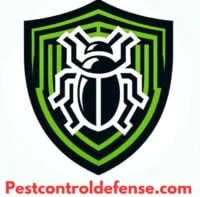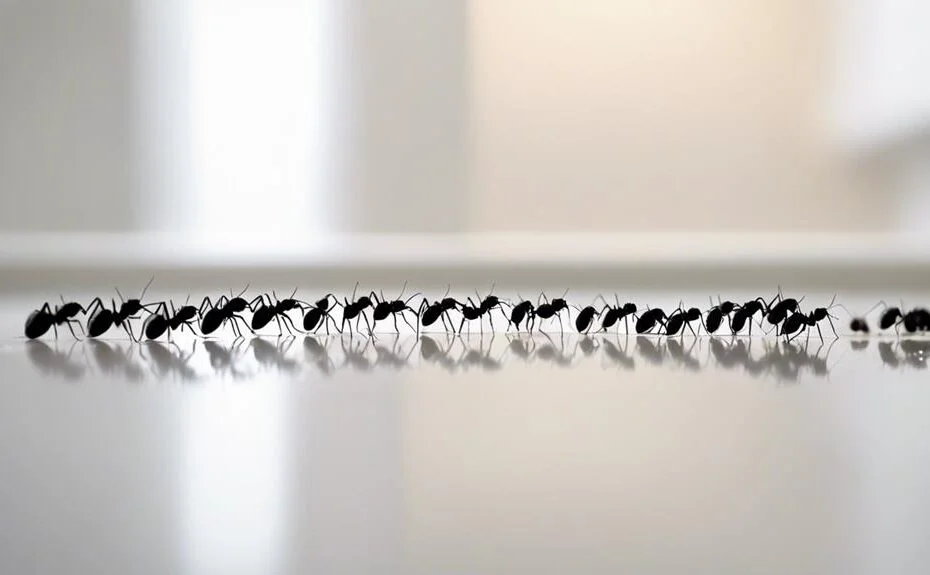The presence of ants in your bathroom can be a common nuisance for many homeowners. These tiny pests can quickly infiltrate this space, leaving many wondering how they got there in the first place.
Understanding the different types of ants that typically invade bathrooms and the reasons behind their presence is crucial in effectively addressing this issue. However, it is important to note that the dangers associated with a bathroom ant infestation go beyond mere annoyance.
Stay tuned to uncover the potential risks and learn about the telltale signs to watch out for in your own bathroom.
Common Types of Bathroom Ants
Among the various species commonly found in bathrooms, ants are particularly prevalent due to their attraction to moisture and potential food sources. Ant behavior in bathrooms is often driven by their search for water, food crumbs, and suitable nesting sites.
The most common ant species found in bathrooms include the odorous house ant (Tapinoma sessile), the Argentine ant (Linepithema humile), and the pharaoh ant (Monomorium pharaonis).
Odorous house ants are small, dark brown ants that emit a foul smell when crushed, hence their name. They are often found foraging for sugary or greasy substances in bathrooms.
Argentine ants are light to dark brown in color and form massive colonies with multiple queens. They are attracted to sweet substances and water sources commonly found in bathrooms.
Pharaoh ants are tiny yellow ants that prefer warm, humid environments like bathrooms. Their colonies can be challenging to eradicate due to their budding behavior, where a queen and a group of workers split off to form a new colony. Understanding the behavior and habits of these ant species can help in effectively managing infestations in bathrooms.
Reasons for Ants in Bathroom
Ants are commonly found in bathrooms due to their attraction to moisture, food crumbs, and suitable nesting sites. When ants invade bathrooms, they exhibit specific behaviors driven by their biology and instincts:
- Foraging Patterns: Ants follow pheromone trails left by scout ants to locate food sources. In bathrooms, they are drawn to water droplets, damp areas around sinks and showers, and even small crumbs left behind.
- Nesting Sites: Ants seek out hidden and protected areas to establish their colonies. Bathrooms provide ideal conditions with hidden crevices, wall voids, and damp spaces that offer protection and moisture for ant colonies to thrive.
- Reproductive Behavior: Ants reproduce rapidly, with the queen laying eggs continuously. Bathrooms with their stable environment and access to water become attractive locations for ant colonies to expand their numbers swiftly.
To address ant infestations in bathrooms, effective ant control measures such as sealing entry points, removing food sources, and using ant baits can help manage and prevent these unwanted intruders.
Dangers of Bathroom Ant Infestation

In the presence of a bathroom ant infestation, the potential risks and hazards posed by these tiny intruders extend beyond mere nuisance. Health risks associated with bathroom ant infestations include the possibility of bites and allergic reactions in individuals sensitive to ant venom. Some ant species can also carry pathogens, contaminating surfaces and potentially leading to the spread of diseases.
Moreover, sanitation concerns arise as ants forage for food and water sources, leaving behind trails of bacteria and other germs as they move around the bathroom. These contaminants can compromise the cleanliness of the space, posing a threat to human health, especially in environments where personal hygiene is crucial.
Additionally, the presence of ants in the bathroom can indicate underlying issues such as water leaks or moisture problems, which can further exacerbate sanitation issues and create a conducive environment for mold growth. Addressing bathroom ant infestations promptly is essential to mitigate these dangers and maintain a hygienic living space.
Signs of Ants in Bathroom
Ants in the bathroom can leave visible trails on the floor, indicating their presence.
Additionally, finding ants near drains is a common sign of an infestation in this area.
Observing these signs can help identify and address the issue promptly.
Ant Trails on Floor
Traversing the smooth tiled surface, intricate trails of tiny insects can often be spotted on the bathroom floor, indicating the presence of ants in the vicinity. These ant trails are a common sight in households and can be indicative of a nearby ant nest. When identifying these ants, keep an eye out for their segmented bodies, elbowed antennae, and distinct waistline. To tackle this issue effectively, incorporating a thorough cleaning routine is essential.
Here are some steps to manage ant trails on the bathroom floor:
- Inspect: Identify the source of the ant trails to determine the entry point.
- Clean: Wipe down surfaces with a vinegar solution to disrupt the pheromone trails.
- Seal: Close off any gaps or cracks where ants may be entering from.
Ants Near Drains
Near bathroom drains, subtle indicators of ant activity may manifest, hinting at the presence of these tiny insects within the bathroom environment. Ants near drains often suggest a potential nesting site or a water source, making it crucial to address this issue promptly. Signs of ants near drains include the presence of ant trails leading to and from the drain, as well as groups of ants congregating around the drain area. To effectively manage this situation, proper drain cleaning techniques are essential to remove any food sources that may be attracting the ants. Additionally, implementing pest control measures can help eliminate the ant colony and prevent further infestations.
| Signs of Ants Near Drains | Importance |
|---|---|
| Ant trails around drains | Indicates ant activity |
| Groups of ants near drains | Potential nesting site |
| Need for drain cleaning | Remove food sources |
Prevention Methods for Bathroom Ants

To deter the presence of ants in the bathroom, meticulous cleanliness and proper sealing of entry points are essential measures to implement. Ants are attracted to water sources and food residues, making bathrooms with their moisture and occasional crumbs a prime target.
Here are some effective prevention methods:
- Natural Remedies:
- Use essential oils like peppermint, tea tree, or citrus, as ants detest these scents.
- Sprinkle cinnamon, cayenne pepper, or coffee grounds near entry points, as these substances act as natural ant repellents.
- Place cucumber or citrus peels near areas where ants enter to discourage their presence.
- Pest Control:
- Seal cracks and crevices with silicone or caulk to block ant entry points.
- Regularly clean drains and fix any leaks to remove water sources that attract ants.
- Use ant baits or traps strategically placed in areas ants frequent, ensuring they are out of reach of children and pets.
Effective Elimination of Bathroom Ants
In the quest to effectively eliminate bathroom ants, a methodical approach involving targeted interventions and persistence is key. Natural remedies can be a gentle yet potent solution in combating these unwanted pests. For instance, a mixture of equal parts water and white vinegar can be sprayed along ant trails and entry points, disrupting their pheromone trails and deterring them from returning. Additionally, essential oils such as peppermint, tea tree, or citrus, known for their repellent properties, can be diluted and applied in areas prone to ant activity.
When natural remedies prove insufficient, professional pest control services may be necessary. Pest control experts can assess the extent of the ant infestation, identify the ant species involved, and implement tailored strategies to eradicate them effectively. These strategies may include targeted baits, insecticidal dust, or barrier treatments to prevent ant re-entry. Moreover, pest control professionals can offer guidance on preventive measures to avoid future infestations, such as sealing cracks and crevices that serve as entry points for ants. By combining natural remedies with expert pest control interventions, the effective elimination of bathroom ants can be achieved.
Frequently Asked Questions
Can Ants in the Bathroom Cause Damage to the Plumbing or Structure of the House?
Ants can indeed cause damage to a house's plumbing and structure. They may nest in walls or crawlspaces, leading to structural weaknesses. Ants seeking water can also find their way into plumbing fixtures, potentially causing clogs or leaks. Prevention methods include sealing entry points, keeping surfaces clean, and addressing moisture issues.
Signs of infestation include visible ants, trails, or nests. Control methods involve identifying the ant species and implementing targeted measures for effective eradication.
How Do Ants Find Their Way Into the Bathroom in the First Place?
Ants utilize a sophisticated system of communication and navigation to locate resources. Their ability to detect chemical signals left by other ants aids in their successful foraging.
In the case of entering bathrooms, ants are attracted by moisture, food residue, or shelter. They may follow scent trails or simply explore new areas. Once inside, they establish routes based on environmental cues.
Understanding these behaviors can help in preventing their entry into unwanted spaces.
Are There Any Natural Remedies or DIY Solutions to Get Rid of Bathroom Ants?
When seeking to address pest issues such as ants, it is common to explore natural repellents and DIY traps as solutions. Natural repellents can include substances like peppermint oil, vinegar, or citrus peels, known for deterring ants.
DIY traps can be created using simple materials like sugar and borax to lure and eliminate ants. These methods are often favored for their non-toxic nature and effectiveness in managing ant infestations.
Do Bathroom Ants Pose a Health Risk to Humans or Pets?
Health concerns arise when ants invade bathrooms. These tiny intruders can carry bacteria and pathogens, posing risks to both humans and pets. Preventative measures are crucial to avoid potential health hazards associated with bathroom ants.
Safeguarding pet safety is paramount, as some DIY remedies may not be pet-friendly. It is imperative to address the issue promptly and effectively to ensure a healthy living environment for all occupants.
Is It Possible for Ants in the Bathroom to Attract Other Pests or Insects?
Ants communicate through pheromones and behaviors like foraging. To prevent ant infestations and deter other pests, maintaining a clean environment is crucial. Control strategies include sealing entry points, eliminating food sources, and using ant baits.
Understanding ant behavior is key in preventing infestations and reducing the likelihood of attracting other pests. By disrupting their communication methods and implementing effective prevention measures, the risk of attracting additional insects can be minimized.
Conclusion
In conclusion, bathroom ants can pose a nuisance and potential health risks if left untreated.
One interesting statistic to consider is that a single ant colony can contain thousands of individual ants, making it crucial to address an infestation promptly to prevent further complications.
By identifying the common types of bathroom ants, understanding the reasons for their presence, recognizing the dangers of infestation, and implementing preventive measures and effective elimination methods, one can effectively manage and control bathroom ant populations.

